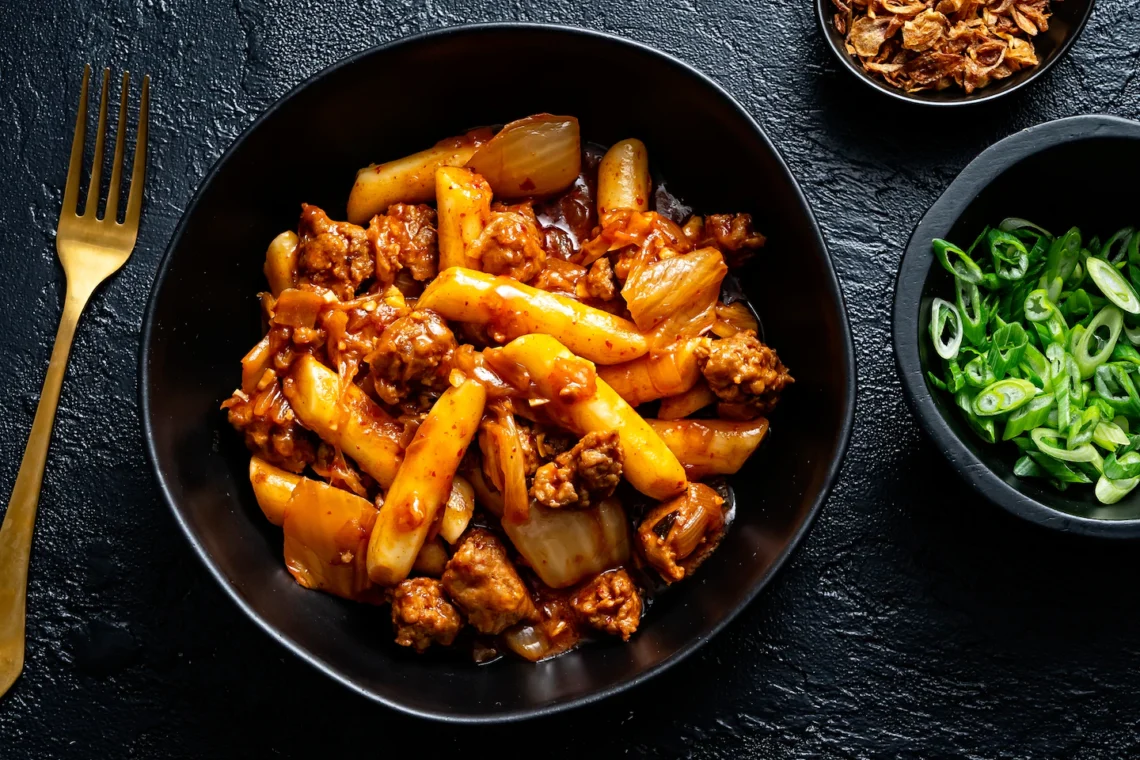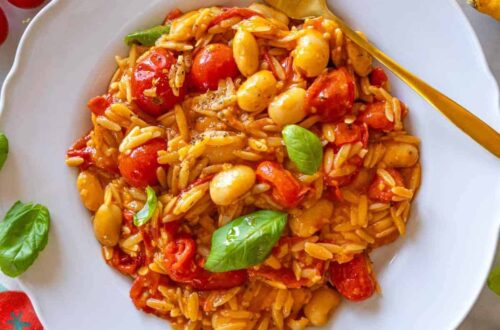Introduction to Sticky Rice Cakes With Sausage and Greens
Imagine biting into a chewy, slightly crispy rice cake coated in a sweet-spicy sauce, paired with savory sausage and vibrant greens. Sticky rice cakes with sausage and greens is a dish that marries textures and flavors in a way that feels like a warm hug from your favorite auntie. This global comfort food, rooted in Asian culinary traditions like Korean tteokbokki and Chinese nian gao, has found its way into kitchens worldwide, each culture adding its own spin. Whether you’re a seasoned home cook or a curious foodie, this dish is approachable yet endlessly customizable, making it a perfect canvas for culinary creativity.
What Are Sticky Rice Cakes?
Sticky rice cakes, known as tteok in Korea or nian gao in China, are made from glutinous rice flour, giving them a signature chewy texture. These cylindrical or oval-shaped delights are a staple in many Asian cuisines, often stir-fried, skewered, or simmered in sauces. Their mild flavor makes them a versatile base for bold ingredients like sausage and greens. From street food stalls in Seoul to family dinners in Shanghai, sticky rice cakes are beloved for their satisfying bite and ability to soak up flavors.
The Role of Sausage in the Dish
Sausage adds a savory, umami-packed punch to sticky rice cakes. Whether it’s Korean Vienna sausages, Chinese lap cheong, or Italian sausage, the meaty richness complements the chewy rice cakes perfectly. The sausage’s fat renders during cooking, creating a flavorful base for sauces and greens. It’s like the best friend who brings the party to a quiet gathering—essential for balance and excitement.
Why Greens Are a Game-Changer
Greens like bok choy, broccoli rabe, or shepherd’s purse introduce a fresh, slightly bitter contrast to the richness of sausage and the chewiness of rice cakes. They add color, nutrition, and a satisfying crunch. Think of greens as the cool, crisp breeze that cuts through a warm, humid day—refreshing and necessary.
A Brief History of Sticky Rice Cakes
Sticky rice cakes have deep cultural roots, particularly in East Asia. In Korea, tteok is a symbol of celebration, often featured in festivals and holidays. In China, nian gao represents prosperity, traditionally eaten during Lunar New Year. The addition of sausage and greens likely evolved as a practical way to create hearty, affordable meals. My first encounter with this dish was at a bustling Korean market, where a vendor handed me a skewer of sotteok sotteok (sausage and rice cake skewers). The sticky, spicy glaze and juicy sausage were love at first bite, sparking my obsession with recreating it at home.
Cultural Variations Across the Globe
From Korea’s spicy tteokbokki to Shanghai’s stir-fried nian gao with pork and greens, this dish adapts to local tastes. In the U.S., chefs have put their spin on it, like at Momofuku Ssam Bar, where tteok meets hot Italian sausage and kimchi. Each variation tells a story of migration, adaptation, and culinary ingenuity, making it a dish that feels both global and personal.
Why This Dish Is Perfect for Home Cooks
Sticky rice cakes with sausage and greens is a dream for home cooks. It’s forgiving, quick to prepare, and requires minimal equipment. Plus, it’s a one-pan wonder, perfect for weeknight dinners or impressing guests without breaking a sweat. The ingredients are accessible, and the dish’s versatility lets you swap in whatever sausage or greens you have on hand. It’s like a culinary choose-your-own-adventure book, but every ending is delicious.
Nutritional Benefits of the Dish
This dish isn’t just tasty—it’s nutritious, too. Sticky rice cakes provide energy-packed carbohydrates, while sausage offers protein and fats. Greens like bok choy or kale add vitamins A and C, plus fiber. Here’s a quick breakdown:
- Sticky Rice Cakes: High in carbs, low in fat, gluten-free.
- Sausage: Protein-rich, but choose leaner options to reduce saturated fat.
- Greens: Packed with vitamins, minerals, and antioxidants.
Balance is key, so pair this dish with a light side to keep things healthy.
Ingredients You’ll Need
To make sticky rice cakes with sausage and greens, gather these essentials. Most are available at local grocery stores or Asian markets:
- Sticky Rice Cakes (Tteok or Nian Gao): 1 lb, cylindrical or oval, fresh or frozen.
- Sausage: 12–16 oz, such as Korean Vienna sausages, Chinese lap cheong, or Italian sausage.
- Greens: 2 cups, chopped (bok choy, kale, or broccoli rabe work well).
- Sauce Ingredients: Gochujang, ketchup, soy sauce, honey, sesame oil, garlic.
- Garnishes: Scallions, sesame seeds, or fried shallots.
- Pantry Staples: Vegetable oil, salt, pepper, water.
Pro tip: If using frozen rice cakes, soak them in warm water for 10–15 minutes to soften before cooking.
Where to Source Ingredients
Sticky rice cakes and specialty sausages like lap cheong are available at Asian markets like Hmart or online retailers. For greens, farmers’ markets offer fresh, seasonal options. If you’re in a pinch, major supermarkets often carry kale or bok choy, and Italian sausage is a solid substitute. I once hunted down tteok at a local Korean grocer, and the owner threw in a free sample of kimchi—score!
Step-by-Step Recipe for Sticky Rice Cakes With Sausage and Greens
This recipe serves 4 and takes about 30 minutes. It’s inspired by Korean sotteok sotteok and Shanghai-style stir-fries, with a nod to global fusion flavors.
Preparation Steps
Start by soaking the rice cakes in warm water for 10–15 minutes to soften. Drain and set aside. This step ensures they cook evenly and don’t stick to the pan. Meanwhile, chop your greens and slice scallions for garnish. If using frozen greens, thaw them first to avoid excess water in the dish.
Cooking the Sausage
Heat 1 tablespoon of vegetable oil in a large nonstick skillet over medium-high heat. Add the sausage (cut into bite-sized pieces if needed) and cook for 5–7 minutes, breaking it apart with a wooden spoon until browned. The rendered fat will flavor the dish, so don’t drain it unless it’s excessive. I learned this the hard way when I accidentally poured out the good stuff—don’t be me!
Adding the Greens
Push the sausage to one side of the pan and add the chopped greens. Sprinkle with a pinch of salt and stir-fry for 1–2 minutes until bright green and slightly wilted. If using heartier greens like kale, add a splash of water to help them soften. The greens should retain some crunch for texture.
Cooking the Rice Cakes
Add the soaked rice cakes to the pan, spreading them evenly. Pour in ½ cup of water or chicken stock, cover, and steam for 2–3 minutes. This softens the rice cakes while keeping them chewy. Uncover, stir gently to avoid sticking, and cook for another 2 minutes until heated through.
Making the Sauce
In a small bowl, whisk together 1 tablespoon gochujang, 1 tablespoon ketchup, 1 tablespoon soy sauce, 1 tablespoon honey, 1 teaspoon sesame oil, and 1 minced garlic clove. Pour the sauce over the rice cakes, sausage, and greens, stirring to coat evenly. Cook for 1–2 minutes until the sauce thickens and clings to the ingredients.
Garnishing and Serving
Transfer to a serving platter and sprinkle with chopped scallions and toasted sesame seeds. Serve hot for the best texture, as rice cakes harden as they cool. For a fun twist, skewer the rice cakes and sausage alternately for a street-food vibe. I once served these at a potluck, and they disappeared faster than my dignity at a karaoke night.
Comparison: Korean Sotteok Sotteok vs. Shanghai Nian Gao Stir-Fry
Both Korean and Chinese versions of this dish are delicious, but they differ in preparation and flavor. Here’s a side-by-side look:
| Aspect | Korean Sotteok Sotteok | Shanghai Nian Gao Stir-Fry |
|---|---|---|
| Rice Cakes | Cylindrical tteok, often skewered | Oval or sliced nian gao, stir-fried |
| Sausage | Korean Vienna sausages or cocktail sausages | Chinese lap cheong or pork |
| Greens | Optional, often minimal (e.g., scallions) | Essential, like bok choy or shepherd’s purse |
| Sauce | Sweet-spicy (gochujang, ketchup, honey) | Savory (soy sauce, oyster sauce, sesame oil) |
| Cooking Method | Pan-fried or grilled, often on skewers | Stir-fried in a wok |
| Flavor Profile | Bold, spicy, street-food vibe | Subtle, savory, homestyle comfort |
Both are crowd-pleasers, but sotteok sotteok is perfect for a quick snack, while nian gao stir-fry feels like a hearty meal. Try both to see which suits your palate!
Pros and Cons of Sticky Rice Cakes With Sausage and Greens
Pros
- Versatile: Swap ingredients based on what’s in your fridge.
- Quick: Ready in under 30 minutes, ideal for busy nights.
- Flavorful: Balances sweet, spicy, savory, and fresh notes.
- Budget-Friendly: Uses affordable ingredients like rice cakes and greens.
Cons
- Texture Sensitivity: Rice cakes can harden if not eaten immediately.
- Specialty Ingredients: Tteok or lap cheong may require a trip to an Asian market.
- Calorie-Dense: Sausage and sauces can add up, so portion control is key.
Tips for Perfect Sticky Rice Cakes
- Soak Rice Cakes: Always soak frozen or refrigerated tteok to prevent sticking.
- Use a Nonstick Pan: Rice cakes are sticky by nature—save yourself the cleanup hassle.
- Balance the Sauce: Taste and adjust the sauce for your preferred spice level.
- Serve Immediately: Rice cakes are best hot and chewy, not cold and hard.
- Experiment with Greens: Try spinach, Swiss chard, or even arugula for variety.
I once overcooked my rice cakes, turning them into gluey blobs. Lesson learned: keep an eye on the clock and don’t walk away from the stove!
People Also Ask (PAA)
What are Korean rice cakes made of?
Korean rice cakes (tteok) are made from glutinous rice flour, water, and sometimes salt, pounded or steamed into a chewy texture. They’re naturally gluten-free and versatile for savory or sweet dishes.
Can I use regular rice instead of sticky rice cakes?
Regular rice won’t work as a substitute because it lacks the chewy, sticky texture of tteok or nian gao. For best results, source sticky rice cakes from an Asian market or online.
How do I store leftover rice cakes?
Store leftovers in an airtight container in the fridge for up to 3 days. To reheat, steam or microwave with a splash of water to restore chewiness. Avoid overcooking, as they can harden.
What sausages work best for this dish?
Korean Vienna sausages, Chinese lap cheong, or Italian sausage are great choices. Avoid beef hot dogs, as they can be too salty. Opt for chicken or pork for authentic flavor.
FAQ Section
Can I make this dish vegetarian?
Yes! Swap sausage for plant-based sausage or mushrooms for a meaty texture. Use a vegetarian oyster sauce or extra soy sauce for umami.
How do I prevent rice cakes from sticking to the pan?
Use a nonstick skillet and plenty of oil. Soaking the rice cakes beforehand also helps. Stir gently but constantly during cooking.
Can I freeze sticky rice cakes?
Yes, freeze uncooked rice cakes in a single layer, then transfer to a freezer bag. Thaw in the fridge before cooking to maintain texture.
What’s the best way to reheat this dish?
Reheat in a covered pan with a splash of water or broth to create steam. Microwave for 30 seconds with a damp paper towel to prevent drying out.
Are sticky rice cakes gluten-free?
Yes, tteok and nian gao are made from glutinous rice flour, which is naturally gluten-free. Double-check sauces for hidden gluten, like in some soy sauces.
Tools and Equipment for Cooking
To nail this dish, you’ll need:
- Nonstick Skillet or Wok: Prevents sticking and ensures even cooking.
- Wooden Skewers: For sotteok sotteok-style presentation (soak in water to prevent burning).
- Small Whisk: For blending the sauce smoothly.
- Colander: To drain soaked rice cakes and greens.
I recommend a 12-inch nonstick skillet—mine’s been a kitchen MVP for years. For skewers, bamboo ones from an Asian market are cheap and effective.
Where to Find Inspiration and Variations
For recipe inspiration, check out food blogs like My Korean Kitchen or The Woks of Life, which offer authentic takes on tteok and nian gao dishes. Instagram and Pinterest are goldmines for creative variations—search hashtags like #sotteoksotteok or #niangao. I once stumbled upon a cheesy sotteok variation on Instagram, and it was a game-changer for my next movie night.
External Resources
- My Korean Kitchen for sotteok sotteok recipes.
- The Woks of Life for Shanghai-style nian gao stir-fries.
- Hmart for sourcing tteok and lap cheong.
Conclusion: Why You Should Try This Dish
Sticky rice cakes with sausage and greens is more than a meal—it’s a journey through flavor, texture, and culture. Whether you’re recreating Korean street food or a Shanghai family recipe, this dish brings people together with its bold, comforting vibes. It’s easy enough for beginners yet impressive enough for guests. So grab some tteok, fire up your skillet, and let this dish become your new kitchen obsession. Trust me, your taste buds will thank you.




